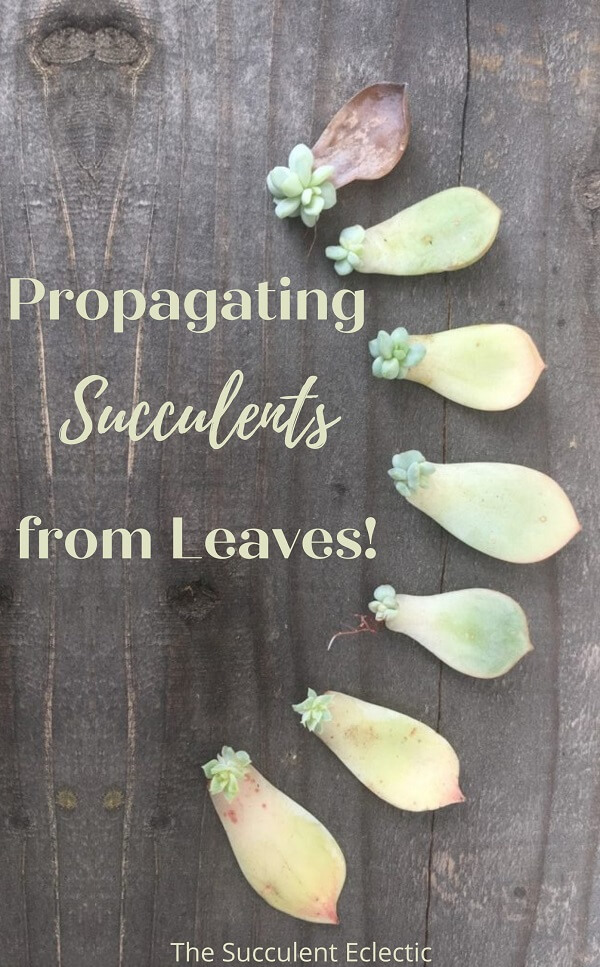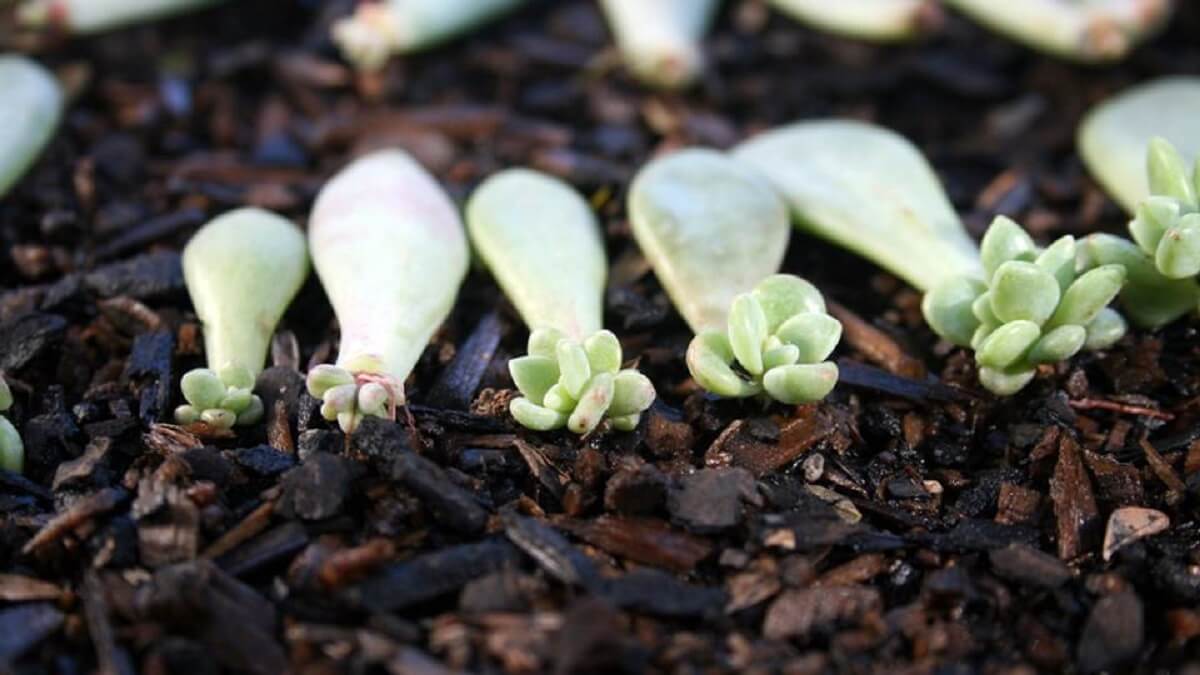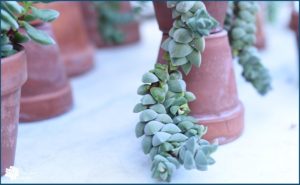PropagatingPropagating (PRAH-puh-gate-ing) a plant is to grow another p... succulents to grow your collection, share with friends and use them in crafts is a fun part of this succulent-loving obsession – I mean hobby. It always seems magical to me that you can take a small part of a plant, and grow it into a whole ‘nother plant! 🙂 Together, we have covered propagating succulents from stem cuttings and from divisions in previous posts. Today, we’ll look at the most magical method of all – propagating succulents from leaves. To grow an entire plant from a single leaf — it’s like getting to play with God’s toolbox!
How to Propagate Succulents from Leaves
In this Post We'll Cover:
- How to Propagate Succulents from Leaves
- Propagating Succulents
{Please note, some links in this post may be affiliate links to sites that pay me a small commission if you click on the link and make a purchase. This commission is at absolutely no cost to you. I only recommend products and companies that I have worked with and truly love! ~Kat}
Propagating Succulents
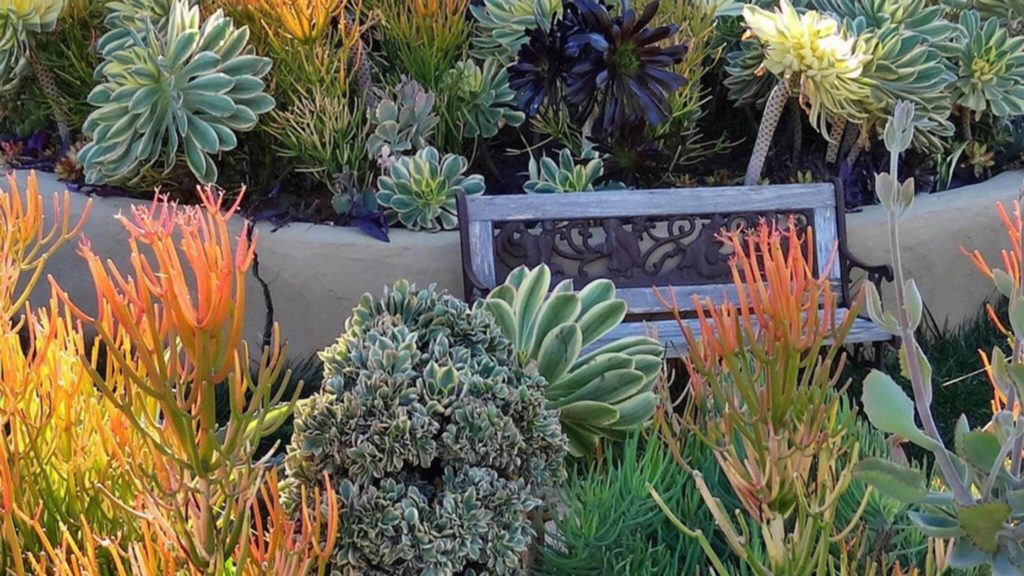
While all succulents can be propagated, different varieties require different methods. There are four main methods of propagating succulents:
- The vast majority of succulents can be propagated by stem cuttings.
- Some succulents have a growth pattern perfect for propagating through division.
- Most succulents can be propagated from a single leaf — see below.
- (Nearly) all succulents can be grown from seed.
Which Succulents Can Be Propagated from Leaves?
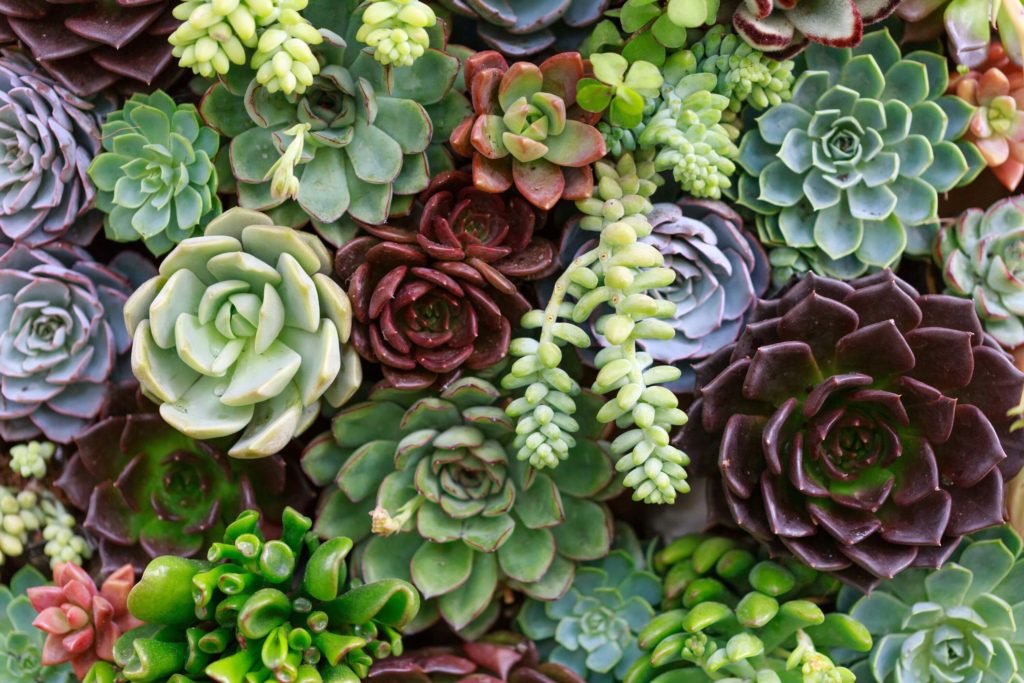
Most succulents can be propagated from a single leaf, though some cannot. How can you know which will work and which won’t? As is often the case with succulents – the plant will tell you! 🙂
All succulents have the drive to reproduce – it is one of the essential functions of life. Like stem cuttings, leaf propagation takes advantage of natural abilities many succulents have developed to adapt to their extreme native climates. Varieties like Echeveria, Graptopetalum and Sedum drop their leaves easily in response to rough treatment from passing animals, root rot, and a variety of other environmental stresses – including handling by loving gardeners! 🙂 “In the wild” this enables these plants to respond to some forms of stress by attempting reproduction. By dropping a leaf that is primed to root and grow, they respond to a current threat by making a bid for future offspring. When you have a healthy succulent that easily drops healthy, plump, firm leaves, it is a prime candidate for leaf propagation.
Other succulents like Aeonium, Portulacaria or Crassula develop a woody, shrub-like growth pattern. Their leaves are much more firmly “attached” than those above, and resist efforts to remove a leaf for propagation. These can be propagated from leaves, though they take much longer. Typically, these varieties are better propagated by stem cuttings.
Still other succulent varieties propagate primarily from offsetsSucculent offsets are the baby succulents that form at the b.... Sempervivum, Agave and Aloes are examples of pup-forming succulents that do not propagate by their leaves. (Yes, Echeveria form offsets, too. But remember how easily they drop their leaves? That is the sign that they will propagate well from their leaves.)
Succulent MeristemMeristem (MEHR-i-stem) tissue in plants contains undifferent... Tissue
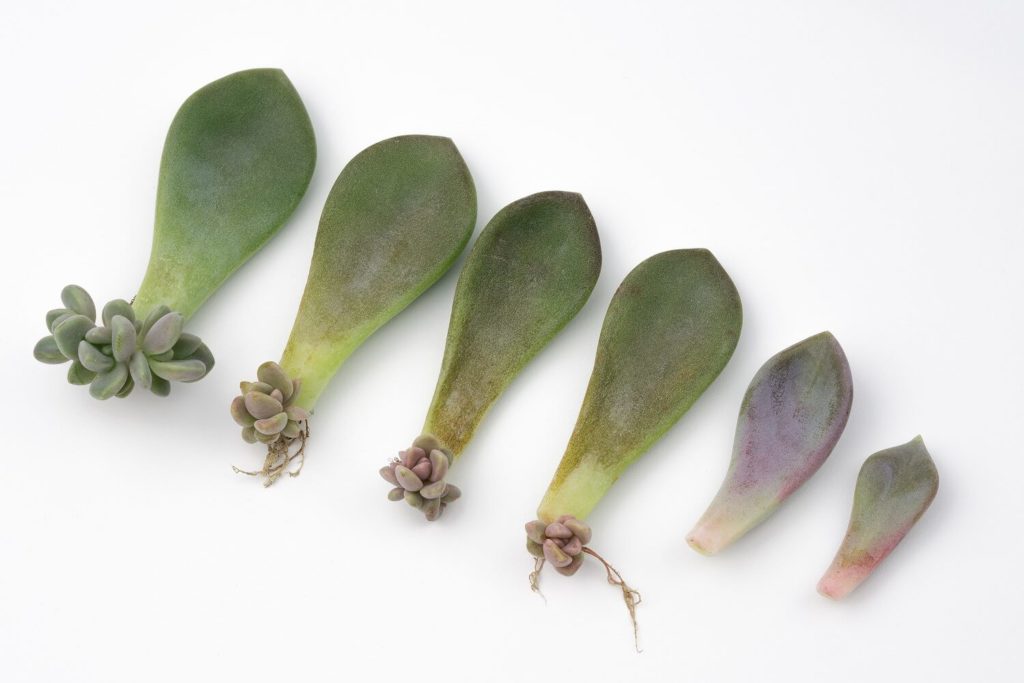
Isn’t this a remarkable sight? Little plants leafing out and forming roots at the base of a single, detached leaf. This is what we are aiming for when we’re propagating succulents from leaves. The reason this works is due to specialized plant cells that form at the junction of the succulent’s leaf and stem. Called “meristem”, these cells can form roots, leaves or new plants, depending upon what is needed. As the plant grows normally, this meristem tissue forms the plant’s leaves. In times of drought, aerial roots may develop instead, to take moisture from the surrounding air. If that part of the stem comes in contact with soil, roots form. And when a leaf is separated from its plant, the meristem tissue will grow a whole new plant. Amazing!
How to Remove Succulent Leaves for Propagation
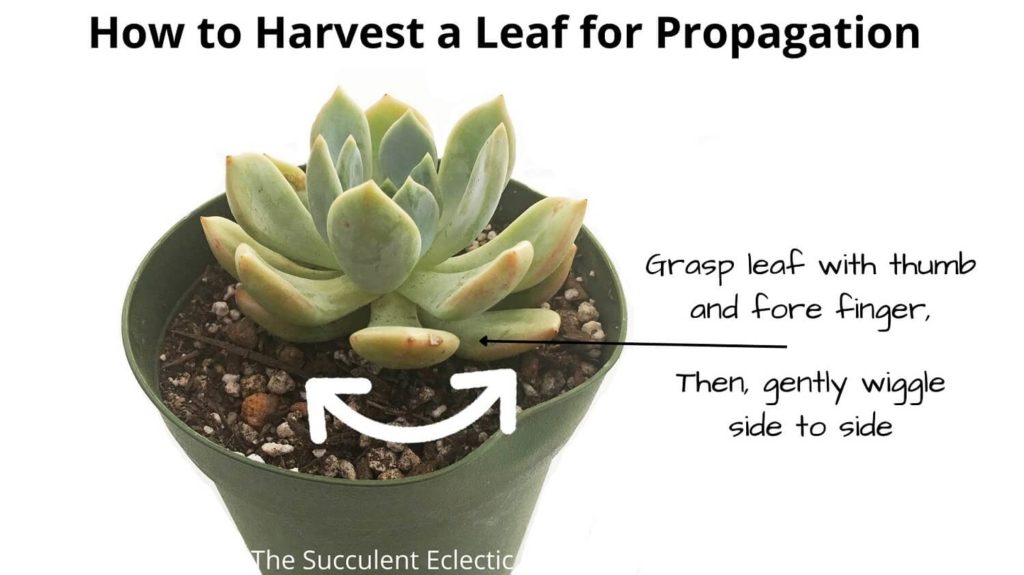
For a leaf to propagate well, it must come from the plant with some of its precious meristem tissue intact.
When a succulent drops its leaves, though they are plump and firm, this is a perfect opportunity to propagate those leaves. When fallen leaves are not available, and you need to take a leaf for propagation, do it like this: Gently grasp a lower leaf between your thumb and forefinger, and move it side to side. If it is a variety that readily propagates from fallen leaves, it will release from the stem with a slight snap and with some of the meristem still attached. It is then ready for propagation.
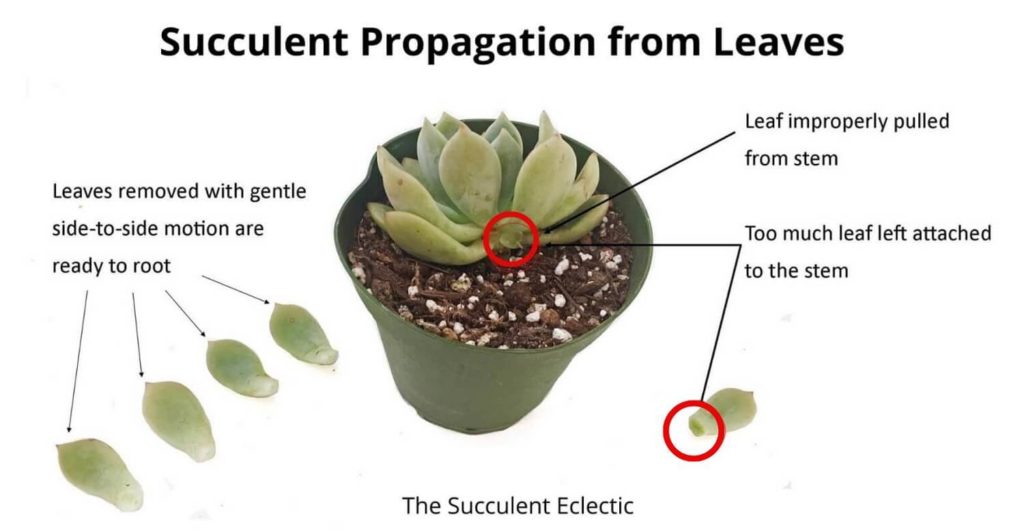
If you simply pull the leaf away from the succulent, it is likely to leave a part of the leaf and that all-important meristem tissue attached to the plant. When this happens, the leaf cannot form roots or new leaves. If it is removed correctly, the end of the leaf is closed. When the leaf is torn from the stem by pulling it, you will see a wound that leaks moisture. A torn leaf will never root.
Take Several Succulent Leaves to Propagate
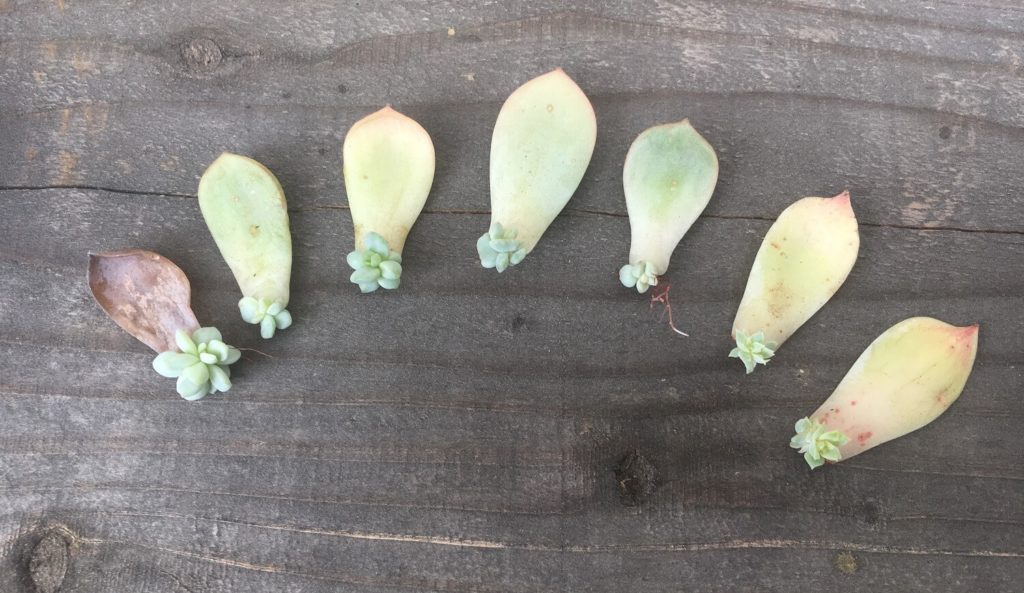
The success rate for propagating succulents from leaves is quite high. But it is not 100%. Although I will set aside a single fallen leaf to root, when I take leaves for propagating, I always take several. That way, you will always be successful. And who doesn’t love even more succulents?
If you are eager to get started, but don’t have any leaves handy, you can order succulent leaves for propagation from The Succulent Source. This is an inexpensive way to increase your succulent collection and knowledge at the same time!
Leave Succulent Leaves to Dry
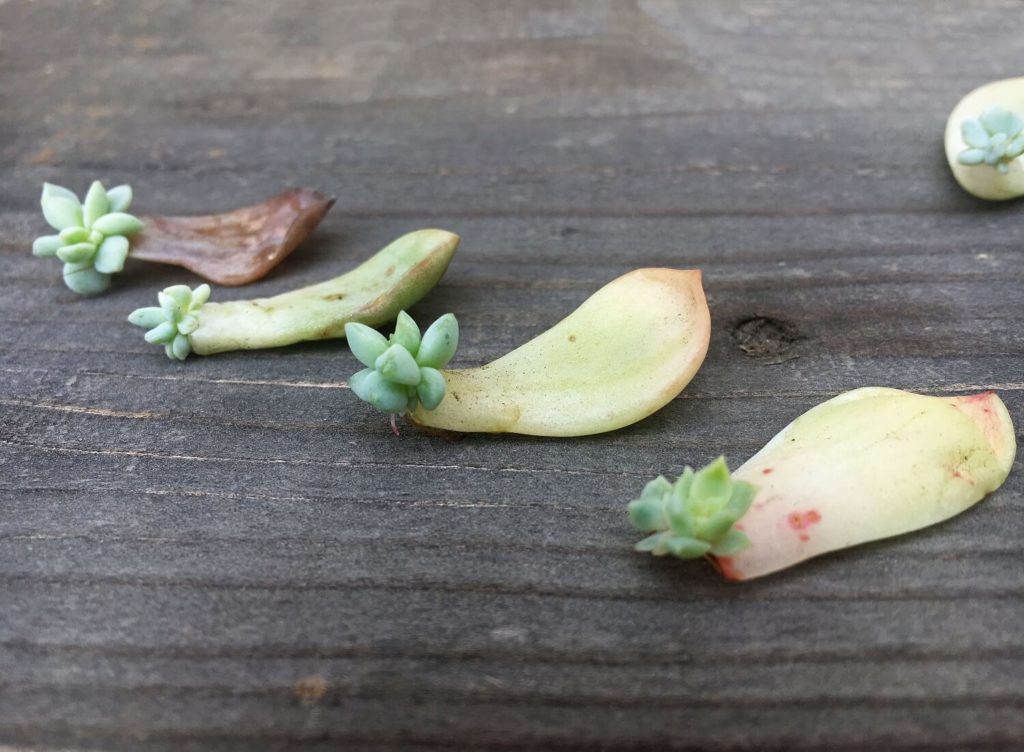
There is no need to use rooting hormone or honey to encourage your leaves to sprout roots. Just leave your succulent leaves dry, and out of direct sun. I usually place mine on a bed of dry succulent soil, in a bit of shade. Until the new, baby roots form to take up water, there is no point in watering your leaves. Too much external moisture risks rotting the leaf before the plantlet forms. Over a few weeks, your succulent leaf will begin to form a cluster of tiny new leaves at the point where it had joined the stem. This is the meristem tissue in action.
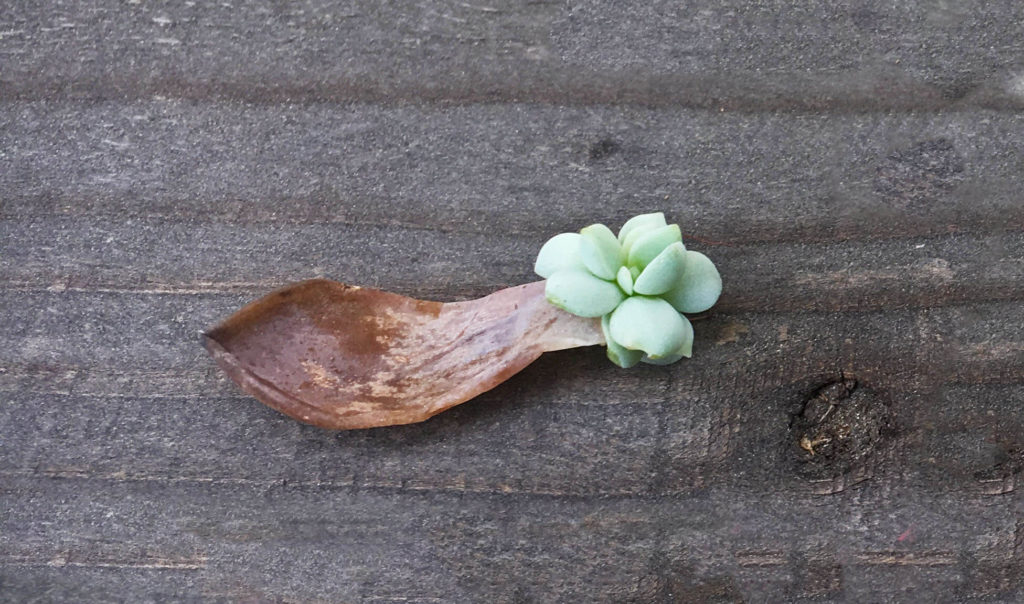
While your the baby plantlet develops, it draws on the moisture and nutrients stored in the leaf. This is why you want to start with a plump, healthy leaf. It will have a greater store of nutrients and moisture to support a plantlet.
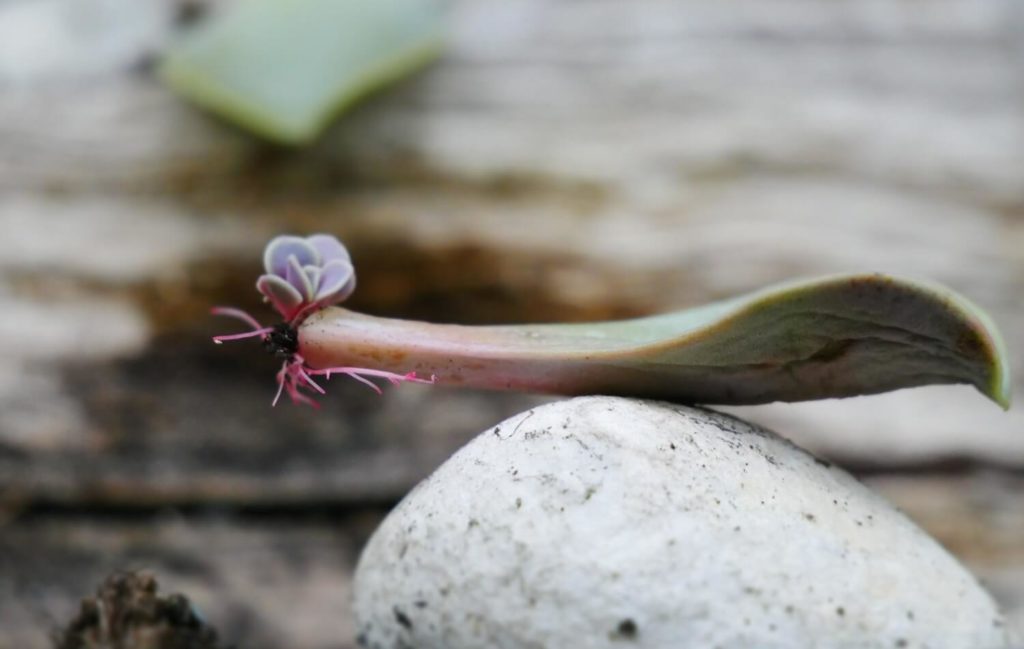
When the roots form, it is time to plant your succulent plantlet, so that it can support itself!
Plant Succulent Leaves Once They Root
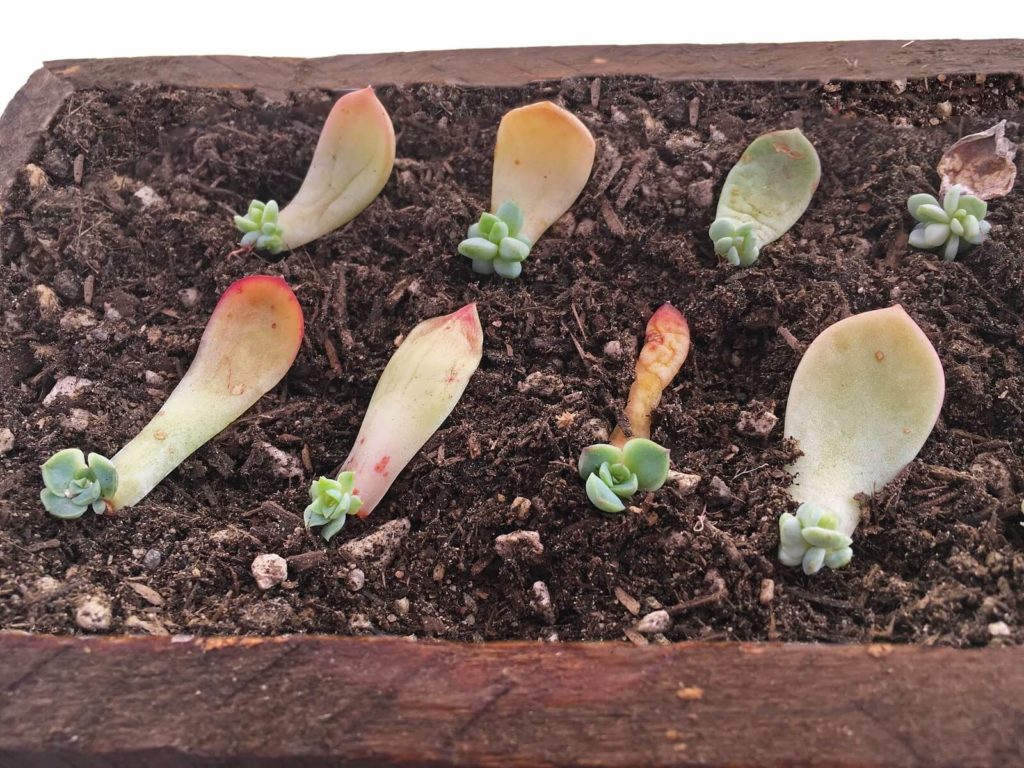
Lay your sprouting succulent leaves onto dry succulent soil. Gently cover the roots with soil. Mist with water to wet the top of the soil. Continue to mist the soil every few days, allowing it to dry in between. Eventually, the original leaf will be consumed by the plantlet as it begins to grow and prosper. Leave your freshly planted plantlets in the bright shade for 4 weeks. When the plantlets show significant growth and are well rooted in, gradually move them into more sunshine.
Congratulations! You have just propagated new succulent plants!
When Succulent Leaf Propagation Produces Only Roots
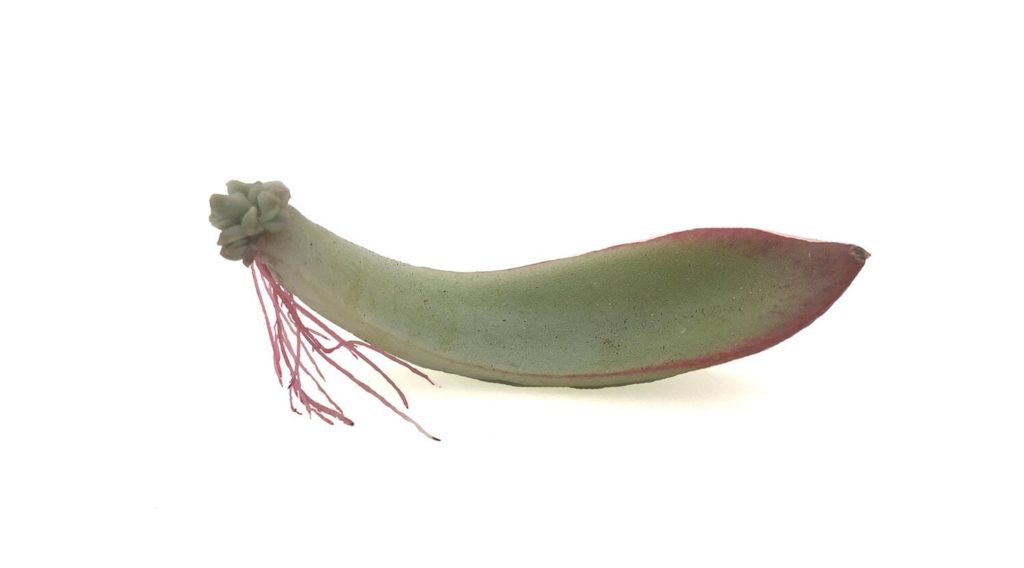
Above is a picture of what we’re all aiming for with leaf propagation — a healthy adult leaf with a plantlet and robust roots. It is ready to be planted. But what happens when your leaf doesn’t develop a baby plant? Sometimes, succulent leaf propagation produces only roots, typically for one of the following four reasons:
- Time — Typically, when propagating succulents from leaves, the roots develop first. It can take weeks, or even longer, for your leaf propagation to develop the baby leaves or plantlet.
- Wrong Succulent — While most succulents work with leaf propagation, some just don’t. Aeonium, Haworthia, Sempervivum and Fenestraria are examples of succulents that either won’t reproduce by leaf propagation, or they take so long, it is not practical.
- Dormancy — When propagating succulents from leaves, it’s important to do so when the plant is awake and actively growing. If you attempt leaf propagation when the succulent is dormant, the leaf will barely change, it won’t root, it won’t form baby leaves, it just stays the same for months at a time.
- We don’t know — Propagating succulents from leaves has a high success rate, but it is less than 100%. This is why I encourage you to set aside several leaves at a time for leaf propagation.
There is a trick that can get some leaves with just roots to produce baby leaves. I recommend doing this only when you have waited at least a month after the roots develop. When you have a leaf that has produced lots of roots, like the one above, but no leaves, grasp about half of the roots and rip them off. Don’t cut them, they need to be torn off. Leave the other roots intact, and set the leaf aside again. When you do this, it will “scare” the leaf propagation, and make it more likely to produce a plantlet. This, too, is not 100% effective, but will boost your chances of getting a plantlet from a really stubborn leaf. I know this sounds drastic, but it works!
How Long Does Propagating Succulents from Leaves Take?
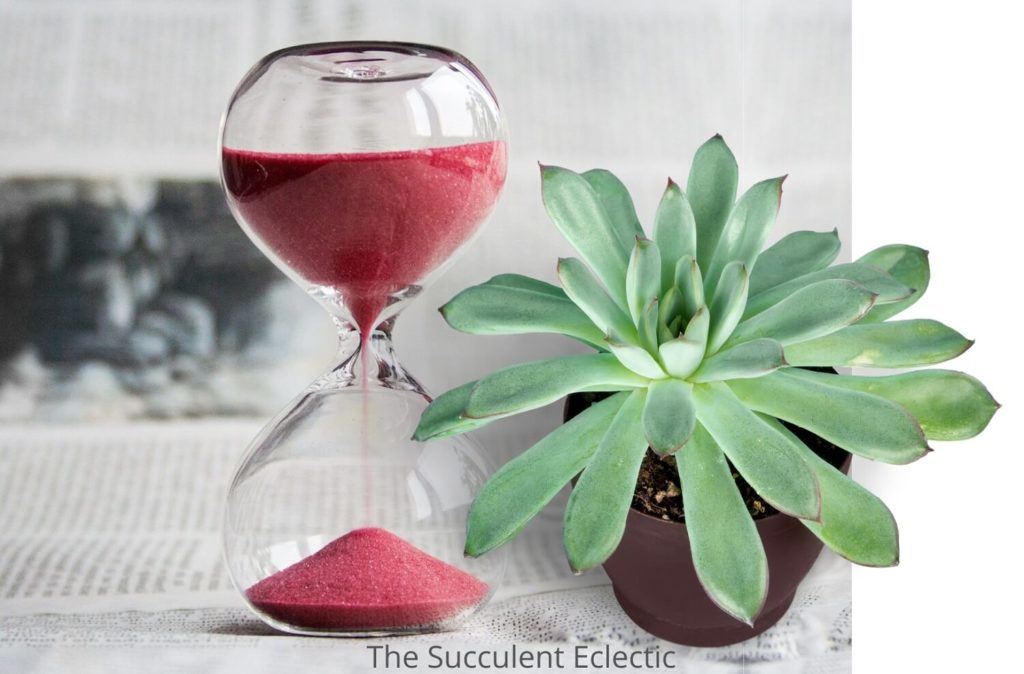
How long will propagating succulents from leaves take? It depends. (Yes, I know that seems unsatisfying). Very generally, you will likely see your first development on the leaf within several weeks. The succulent variety, heat, humidity and the time of year will all have an impact on the propagation timeline. You can propagate at any time of the year. But some succulents are semi-dormant in the summer, while others are nearly dormant in the winter. When the succulent is naturally less active, it will be slower to propagate. In general, spring is a good time to propagate with the quickest results.
Yes, it takes as long as it takes. Don’t count on new plants of a certain size in x number of weeks or months. Even leaves taken from the same plant may take very different times to develop new leaves and roots. And a few may never develop. Just don’t give up on them. As long as the leaf is plump and not torn, there is reason to hope it will develop. If the leaf becomes mushy, or wrinkles up and dries out, it is time to discard it. Otherwise, give it more time.
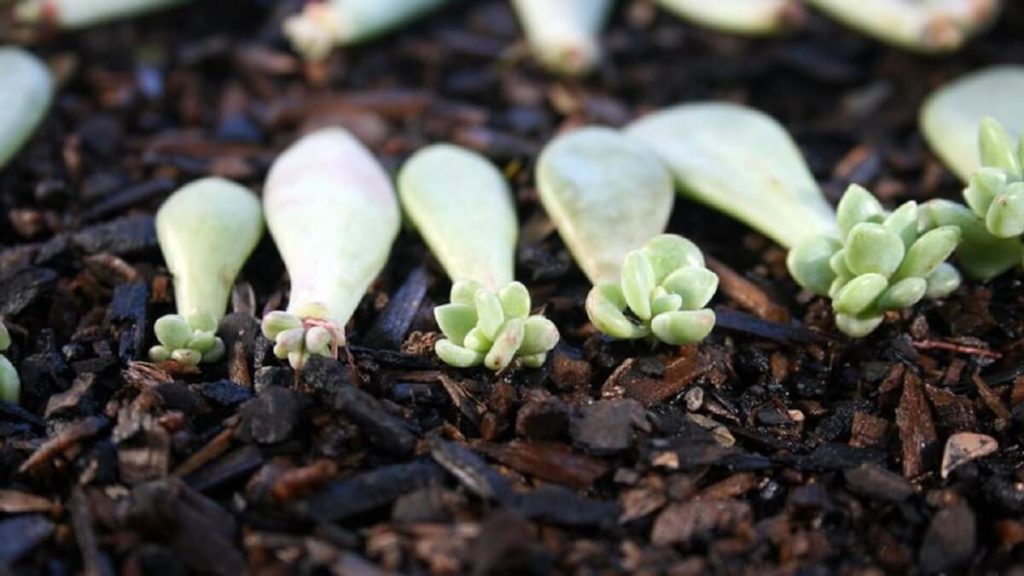
Every time I transplant, relocate or craft with a succulent, I am always alert to save fallen leaves for propagation. Now that you know the process, are you eager to start? I would love to hear how it goes for you — please leave a comment! And if you have any questions – let me know. I am happy to help!
You can do this – I promise!

P.S. Get my FREE course on succulent care, 7 Steps to Succulent Success, by subscribing. Thanks so much!
P.P.S. Why not join my Facebook Group for succulent lovers? We talk about succulent care, propagation, succulent identification, and design. It’s a warm and welcoming group that would love to meet you!
